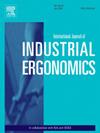Attractiveness factors of the use of retro products to young people: A mixed-method approach with user experience analysis
IF 3
2区 工程技术
Q2 ENGINEERING, INDUSTRIAL
International Journal of Industrial Ergonomics
Pub Date : 2025-01-01
DOI:10.1016/j.ergon.2025.103695
引用次数: 0
Abstract
This study adopted a mixed-method approach to identify attractiveness factors from multiple perspectives. First, a qualitative survey (Survey 1) was performed to obtain the hypothesis factors of three retro products by analyzing user experiences using the UX curve method and the KJ method. From these results, nine categories were extracted as hypothesized factors that create attractiveness in the use of retro products. Second, a quantitative web-based questionnaire (Survey 2) was conducted to verify the hypothesized factors. The questionnaire items were created based on the nine hypothesized factors extracted from Survey 1. Next, a five-factor model of the attractiveness of retro products was extracted through factor analysis of the results from Survey 2. The five factors are: “excitement,” “attractiveness due to time and effort,” “instinctive attractiveness,” “attractiveness due to inconvenience,” and “novelty. Finally, multiple regression analysis was performed, which revealed that "attractiveness due to time and effort,” “instinctive attractiveness,” “attractiveness due to inconvenience,” and “novelty. Finally, multiple regression analysis was performed, which revealed that "attractiveness due to time and effort" and "instinctive attractiveness" have the greatest impact on the attractiveness of retro products.
年轻人使用复古产品的吸引力因素:用户体验分析的混合方法
本研究采用混合方法,从多个角度识别吸引力因素。首先进行定性调查(survey 1),利用用户体验曲线法和KJ法对三款复古产品进行用户体验分析,获得假设因子。从这些结果中,我们提取了9个类别,作为在使用复古产品时创造吸引力的假设因素。其次,采用基于网络的定量问卷(调查2)来验证假设的因素。问卷项目是根据从调查1中提取的九个假设因素创建的。其次,通过对调查2的结果进行因子分析,提取了复古产品吸引力的五因素模型。这五个因素是:“兴奋”、“由于时间和努力而产生的吸引力”、“本能吸引力”、“由于不便而产生的吸引力”和“新奇性”。最后进行多元回归分析,结果显示“时间和努力吸引力”、“本能吸引力”、“不便吸引力”和“新颖性吸引力”。最后进行多元回归分析,发现“因时间和努力而产生的吸引力”和“本能吸引力”对复古产品吸引力的影响最大。
本文章由计算机程序翻译,如有差异,请以英文原文为准。
求助全文
约1分钟内获得全文
求助全文
来源期刊
CiteScore
6.40
自引率
12.90%
发文量
110
审稿时长
56 days
期刊介绍:
The journal publishes original contributions that add to our understanding of the role of humans in today systems and the interactions thereof with various system components. The journal typically covers the following areas: industrial and occupational ergonomics, design of systems, tools and equipment, human performance measurement and modeling, human productivity, humans in technologically complex systems, and safety. The focus of the articles includes basic theoretical advances, applications, case studies, new methodologies and procedures; and empirical studies.

 求助内容:
求助内容: 应助结果提醒方式:
应助结果提醒方式:


